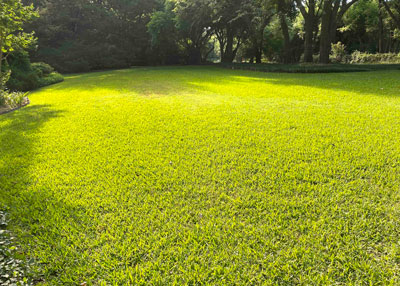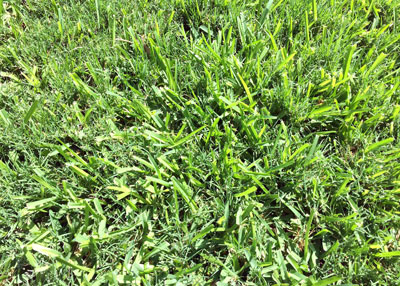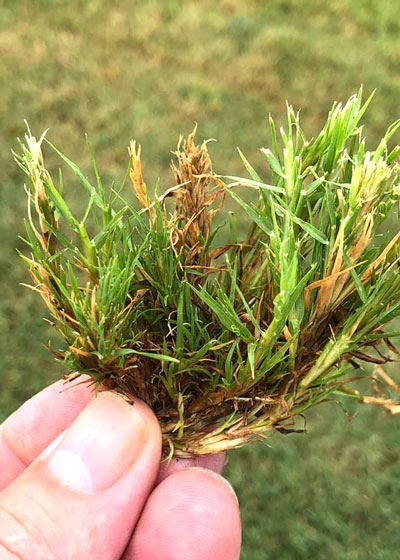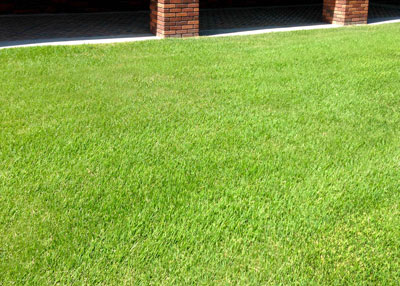St. Augustine Musings: June 18, 2020

I took this photo up the hill from our house last week. As I looked at it on my computer I began to realize a lot of things I wanted to share with you. I think it would be best if I just blurted them out. They may be a little bit random. I’ll wrap it up with some curious details about this specific photo. Don’t miss those.
My observations after decades with St. Augustine…
• I grew up with St. Augustine in College Station. There were no variety names assigned to it back then. Just “St. Augustine.” It later came to be called “common St. Augustine.”
• Now we have many improved selections of St. Augustine. Look for variety names like “Raleigh,” “Floratam,” “Delmar,” “Palmetto” and others.
• Most lawns in the southern half of Texas were St. Augustine. Most in the northern half were, and still are, bermuda.
• People from the North think St. Augustine looks like a weed – big, wide blades that remind them of crabgrass. (The two grasses are indeed cousins.)
• Most gardeners love St. Augustine, because it only produces runners above ground (stolons). They’re easier to pull out of flowerbeds.
• Most athletic field managers prefer bermudagrass because it produces runners both above ground and below ground (rhizomes). It stands up to pedestrian abuse far better than St. Augustine.

• St. Augustine is the most dominant turfgrass we have. It crowds out bermuda and zoysia. It just won’t crowd out dallisgrass or nutsedge.
• St. Augustine has historically had more insect and disease problems than bermuda (including take all root rot, gray leaf spot, chinch bugs, brown patch and St. Augustine decline). But bermuda is catching up with a recent increase in bermuda mites, at least by my measure. The grasses are equally susceptible to damage by white grub worms.

• St. Augustine is less winter-hardy than bermuda. In fact, in DFW where I live and garden, I lost my entire lawn (Raleigh St. Augustine) following an extremely cold night in December 23, 1989, when our Collin County thermometer recorded -4F. Bermuda turf was not hurt.

• Enter zoysias. In many respects they are intermediate to St. Augustine and bermuda. Finer textured than St. Augustine and coarser than bermuda. More tolerant of shade than bermuda, less than St. Augustine. And so forth. More expensive to plant, but an increasingly popular option.
To explain my photo in particular…
• This is a 1-acre parcel of land that was carved out of almost 11 acres back in 1977 so that Lynn and I could establish a Texas homestead and build our house.
• Our actual landscape was out of frame to the left. This was just a rustic old field of weeds and stubble. I hired a neighbor with a blade to smooth it off, and I got bermudagrass started. Our boys and I played a lot of ball on that field.
• About 1985 a small tree died and needed to be removed. It left a hole about the size of a wheelbarrow load of soil. I had just such a load left over from a spot down in our yard, so I used it to even the ground.
• In that soil were a few sprigs of St. Augustine. Somehow they took root, and now they have grown to cover an acre. No other St. Augustine has ever been planted here.
And most surprising to me…
• As I looked at my photo I realized that I haven’t watered that hillside for probably 30 years. There have been some awful droughts during that time. 2011 was biblical. No irrigation.
• Now, in honesty, there is one time per year when sprinklers do sit atop this hill for a couple of days. I overseed this turf with annual ryegrass in late September for winter green color, and I water it the day that I plant it. But that’s it. I’m watering the ryegrass just that one time, and never the St. Augustine.
• Fertilizer? It’s the same as with the irrigation. I feed the ryegrass one time in February. It uses it up, so that by the time the St. Augustine greens up in April, I’m sure there’s very little of the nitrogen left for it to utilize.
• And most curiously, even though this entire hillside is in full sun, I have never had a problem with chinch bugs, gray leaf spot or take all root rot. Of course, the nitrogen levels are low, so that helps with the gray leaf spot, and drainage is perfect (and I’m not watering), so those help with the take all root rot. But still, this grass is really tough. And this grass survived the -4F that cold December night back in ’89.
My takeaway from it all: We coddle our St. Augustine (and probably bermuda and zoysia) too much. We shouldn’t over-react and swing back completely to the other extreme, but feeding and watering aren’t always the solution to every problem our lawns encounter.
Funny how one quick snapshot when you’re up checking on things causes you to start thinking, isn’t it!
